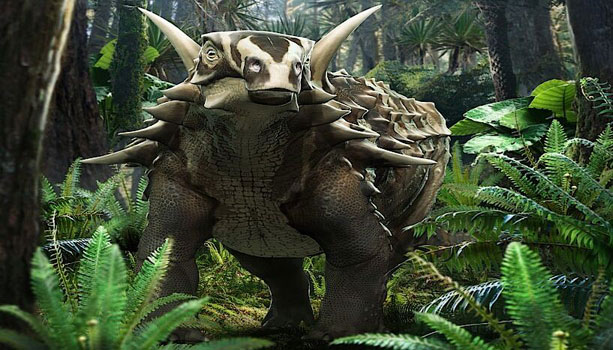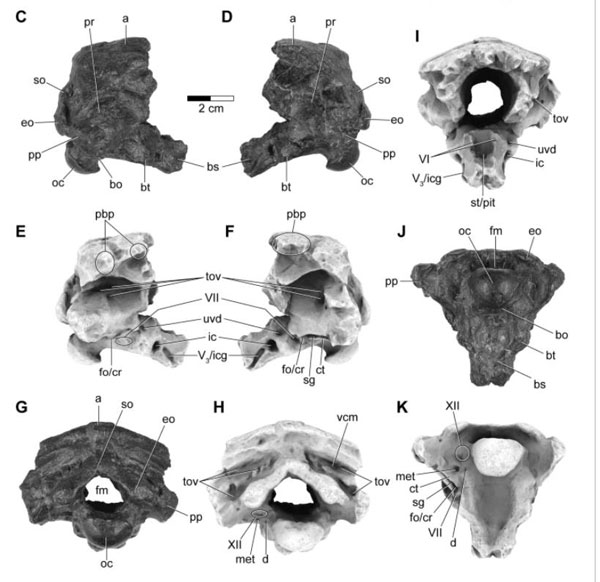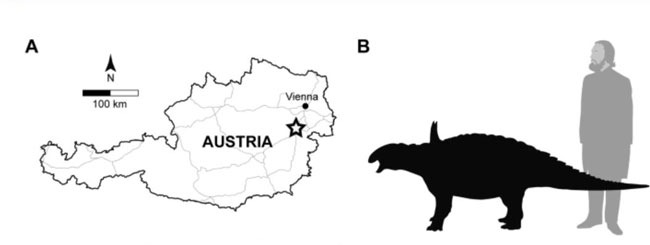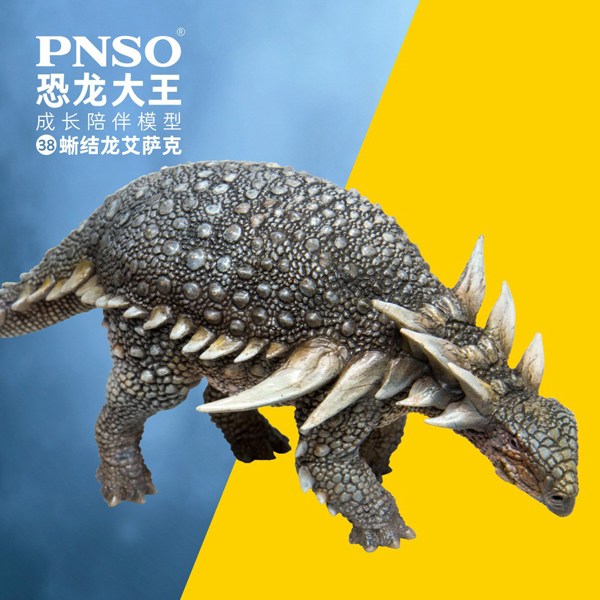A New Study of Struthiosaurus austriacus – Differences Between Nodosaurids and Ankylosaurids
A study published this month in “Scientific Research” suggests that the Late Cretaceous European nodosaurid Struthiosaurus was not the most active of dinosaurs and probably not the most social. Analysis of the single, partial braincase (IPUW 2349/6) of S. austriacus has permitted scientists to gain a better understanding of this armoured dinosaur’s senses. The conclude that the short semi-circular canals and the shortest cochlear duct described from dinosaur fossils known to date, indicate that Struthiosaurus led a rather inert, sedentary life and compared to other members of the Dinosauria, it was comparatively inactive with limited social interactions.
The researchers calculate that Struthiosaurus had poor hearing and it probably relied on a less active style of self-defence compared to their tail club swinging relatives the ankylosaurids.

An illustration of the Late Cretaceous nodosaurid Struthiosaurus austriacus from Austria. A study of this dinosaur’s braincase suggests that it was relatively inert, sluggish and partially deaf. Picture credit: Fabrizio De Rossi.
Picture credit: Fabrizio De Rossi
Sluggish and with Limited Hearing
Researchers from the University of Vienna in collaboration with a colleague from the University of Greifswald in Germany subjected the partial braincase of S. austriacus to CT scans. From this information, three-dimensional models of the 5 cm wide braincase of this dinosaur were created.
The braincase consists of several fused skull bones that housed the brain and other neurosensory tissues. Analysis of the structures preserved can provide palaeontologists with information about the sensory capabilities of the animal and more fundamental details of anatomy such as the angle at which the animal held its head.

Photographs (C,D,G,J) and photogrammetric models (E,F,H,I,K) created from the CT scans of the holotype specimen of Struthiosaurus austriacus, (IPUW 2349/6). Right lateral view (C,E), (D,F) left lateral, (I) anterior, (J,K) ventral and (G,H) posterior views. Note scale bar = 2 cm. Picture credit: Schade et al.
Picture credit: Schade et al
The results of this study of the braincase of Struthiosaurus indicate that its brain was very similar to the brains of other nodosaurids. For example, the flocculus, an ancient part of the tetrapod brain, associated with co-ordination and motor skills was very small. Ankylosaurs with their large tail clubs, such as Euoplocephalus had a proportionately larger flocculus. A bigger flocculus might have helped ankylosaurs to co-ordinate their defensive strikes with their powerful tail clubs.
In addition, the team which included Marco Schade (University of Vienna), plotted the auditory capacity of Struthiosaurus and calculated that its hearing range was rather limited (between 296 and 2164 Hz). In contrast, humans on average have a much broader frequency of hearing range – around 31 Hz to 19,000 Hz.

Location of the Struthiosaurus austriacus fossil finds in Austria (A). To date three species of Struthiosaurus have been scientifically described, S. transylvanicus from Maastrichtian-aged deposits or Romania, S. languedocensis from the early Campanian of France and S. austriacus which was described from fragmentary fossil material including a partial braincase discovered during coal mining operations near the town of Muthmannsdorf (early Campanian Grünbach Formation). The type locality of S. austriacus is marked by the star. Scale drawing of S. austriacus from Fabrizio De Rossi. Picture credit: Schade et al.
Picture credit: Schade et al
Nodosaurids Occupied a Different Ecological Niche
Both nodosaurids and their close relatives, the ankylosaurids were lumbering, heavily armoured animals adapted to low browsing. Although postcranial fossils are quite similar, there is a growing body of evidence to indicate marked differences between these two types of dinosaur. Nodosaurids may have preferred coastal or floodplain environments and may have evolved stronger jaws to give them a more powerful bite, an adaptation to processing tough vegetation. Gut contents associated with nodosaurids such as Borealopelta markmitchelli, suggest they were selective feeders: Borealopelta was a Fussy Eater.
This study suggests that for Struthiosaurus at least the combination of a relatively short cochlear duct, a reduced flocculus, less elaborate nasal passages and the absence of a tail club but with heavily reinforced dermal armour suggests that nodosaurids had different ecological adaptations when compared to ankylosaurs.
The researchers postulate that nodosaurids were possibly less reliant on their sense of hearing, had a less active style of self-defence and may have occupied different ecological niches than ankylosaurids.
Struthiosaurus may have lived alone and may not have moved in social groups.

The recently introduced Isaac the Sauropelta model depicts the typical armour and spikes of a nodosaur. These dinosaurs may have been relatively slow moving, with a limited sense of hearing but they would have represented a formidable adversary for a younger theropod.
The scientific paper: “Neuroanatomy of the nodosaurid Struthiosaurus austriacus (Dinosauria: Thyreophora) supports potential ecological differentiations within Ankylosauria” by Marco Schade, Sebastian Stumpf, Jürgen Kriwet, Christoph Kettler and Cathrin Pfaff published in Scientific Reports.
The Everything Dinosaur website: Dinosaur Toys.

